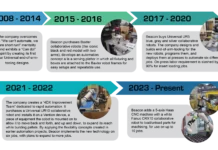by Dino Caparco, engineering operations manager
Yushin America, Inc.

Ensuring success for an automation project or initiative starts before the project is selected. Many organizations select projects that may not make sense or may not be within the capabilities of their support staff. This could lead to a failed attempt or a return on investment that is just a fraction of what was anticipated.
A company first should look inward to determine what level of automation it is able to support. If the organization currently has some basic automation, it may be ready for more complex automation projects. If there is no automation experience, a company may not be capable of supporting an extremely complex automation cell. With a lower level of automation experience, consider the complex projects – but possibly phase them in to build up the complexity once efficiency is established in the first stages.
A big aspect of success in automation is having a support staff that is automation-centric. The automation team should have some mechanical, electrical and pneumatic skills. The organization should be disciplined at tracking uptime and ensuring that errors are well documented so problems are solved at the root cause. It takes a very systematic approach to understand the components of automation and to ensure the equipment is running with maximum uptime.
Once the competency of the organization is understood, it can be determined which supplier will be the best to work with. When choosing an automation supplier, there are a number of considerations.
The reputation of the supplier, ease of use of equipment and value the supplier can add to the organization are a few of the points to review. Ensure the supplier has an adequate support staff with strong engineering capabilities and service technicians nearby. Make sure the supplier has the ability to support multiple customers with adequate staffing. The supplier should be adding value and helping to find projects that yield a return on the company’s investment into automation.
Generate a specification for the project that will be automated. Specifications should be based on the organization’s relevant standards or requirements. Safety requirements should be included in the specifications. Keep in mind: Over-specifying through excessive specification requirements will add costs and complexity.

A number of components should be included in the overall project process. First, a detailed project timeline is required to help identify critical path items and any aspects of the project that may be lagging (see Figure 1). A lead resource should be assigned to communicate with the supplier and ensure all information required to start the project is available. There should be continuous communications with some type of documented communication notes that identify open items, assigned owners and history of closed items (see Figure 2). The initial concepts and automation layout should be reviewed by stakeholders within the organization.
The supplier also should conduct design reviews via phone or online meetings so the organization implementing automation has a chance to review the equipment before fabrication. Customer approvals are typically required before fabrication can start. After fabrication and assembly of the equipment, the vendor should go through the testing and debug process so the equipment is ready for a pre-ship run-off or acceptance test before shipping.
Before the automation equipment leaves the vendor’s facility, the ordering company should attend a run-off to view the equipment running. This will allow the company to review how the equipment runs, as well as mechanical components, software sequences and error recoveries. This also will provide an opportunity to ensure items listed in the specifications have been addressed. This is a good time to discuss preventive maintenance, spare parts and the requirements for receiving the equipment at the facility.
Before the installation, the automation supplier should generate some type of installation plan to identify pre-install requirements, as well as install support requirements. During the installation, it is wise to allocate a resource to work with the supplier on the start-up so at least one person has some deeper knowledge of the equipment. Once the equipment is installed and running, a final run-off should be done with the equipment at the required cycle time. The equipment uptime and any errors should be documented during the run-off.
After a successful run-off, the technician should train required personnel on automation start-up, error recoveries and basic troubleshooting. At this point, the level of authorization should be set and password protected to allow only the proper personnel access to the teach and change functions vs. the basic start and stop functions. This means getting the right people trained on the equipment.
There should be work instructions for operators, and spare parts for consumable items should be stocked. The error data and uptime should be tracked, along with any tweaks or changes that have been made to the equipment. This helps people in the organization understand any changes and also is good documentation to provide to the automation supplier when looking for support.
Following a systematic process for troubleshooting will enable the company implementing automation to get to the root cause of errors and problems with the equipment.
Dino Caparco is the engineering operations manager at Yushin America, Inc. Caparco has worked at Yushin America, Inc., for 19 years and has extensive of experience with robotics, end-of-arm tooling and custom automation equipment. Caparco has worked with manufacturers throughout the US that make components to serve a number of industries, including medical, consumer goods, automotive and packaging. Caparco holds a B.S. in mechanical engineering from The University of Rhode Island and a masters in business administration from Bryant University. For more information, contact Caparco at 401.490.4955 or dcaparco@yushin.com.




